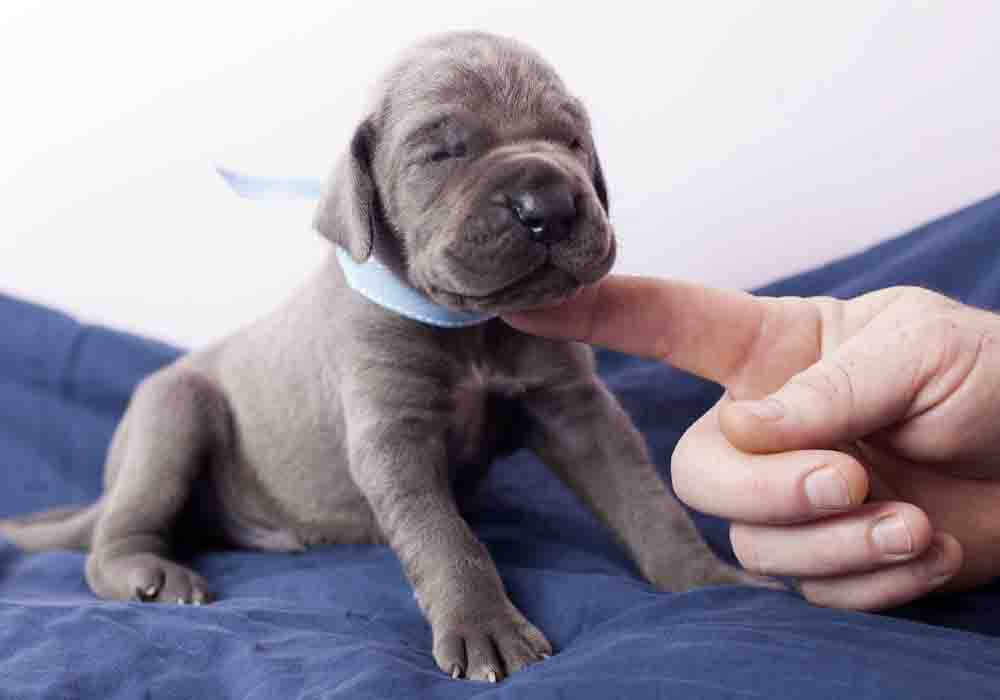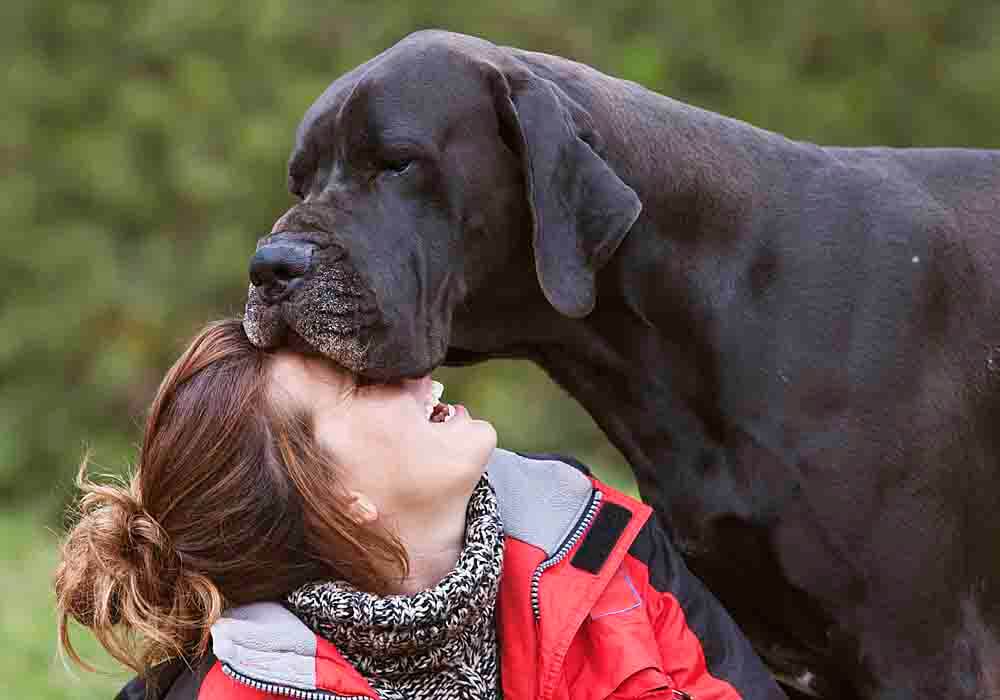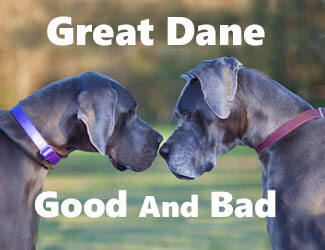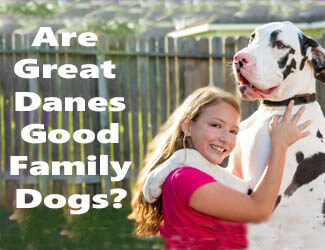Great Dane Puppy 101
Top 15 Beginner Questions Answered
by Ken Alden
Upon bringing home your new Great Dane puppy, you’ll likely have many questions about properly caring for and accommodating them in their new home. To help with your learning process, we’ve compiled the 15 most common questions asked by beginner Great Dane owners.
Great Dane Puppy 101...Some Basics
Great Dane puppies spend around 1.5 years in the puppy stage, reach full size by 18–24 months, develop 42 adult teeth by eight months old, and likely have brown eyes. They’re also more susceptible to bloat, suffer from frequent bouts of hiccups, and sleep 16–20 hours a day.
To learn more about how to take care of your Great Dane puppy, keep reading. I’ll cover the questions you have relating to your dog’s diet, health, and development in this guide.
Pro-tip: Ever try lifting a Great Dane? Their weight can hurt not only your back but their joints when they hop down from cars, sofas or even your bed. To protect your back and theirs check out the best Mastiff ramps on Amazon.com now.

At What Age Does a Great Dane Puppy Calm Down?
Great Danes stay in their puppy stage a bit longer than most dogs, and they start to calm down as they reach full size and adulthood at around 18 to 24 months. Your Great Dane puppy should ease into a calmer and less chaotic temperament at around two years of age.
At What Month Do Great Dane Puppies Lose Their Teeth?
Your Great Dane will begin losing their 28 puppy teeth at around three to five months old.
The process of losing puppy teeth takes several months, and your dog will be teething heavily as their adult teeth grow in. Eventually, your Great Dane will have a complete set of 42 adult teeth by around eight months old.
When Do Great Dane Puppies’ Eyes Change Color?
All puppies are born with blue eyes, and your Great Dane’s eyes will start to change color at around two to three months old. Some Great Danes’ eyes stay blue due to a rare genetic mutation known as the Merle gene.
Your puppy’s eyes could end up brown, grey, blue, or even a mixture of two or three colors. However, the majority of Great Danes have brown eyes upon reaching three months of age.
Pro-tip: Great Dane anxiety, aggression, destructive chewing, jumping up, fearfulness, and other behaviors can be controlled with the right training program.
Here’s a great course that
addresses these issues along with many other dog training basics: Check it out now!
Do Great Dane Puppies Get Bloat?
Great Dane puppies can get bloat, also known as gastric dilatation-volvulus or GDT, and the breed is among the most susceptible to the condition due to their deep and narrow chests. The condition is extremely painful for dogs, as their stomach twists in on itself and rapidly fills with gas, fluids, and food.
Symptoms of bloat include:
- Emotional distress, restlessness, or anxiety
- Swollen abdomen
- Excessive drooling or slobbering
- Frequent retching with no vomit
- Pacing
- Heavy, rapid breathing or panting
If you suspect your Great Dane puppy is experiencing bloat, see a qualified veterinarian immediately, as the condition can quickly become fatal if left untreated.
Surgery may be necessary to treat bloat.
To prevent your puppy from developing this condition, monitor them closely while they eat and try to prevent them from overeating or drinking too much water too quickly. Stress can also increase the risk of bloat.
When Do Great Dane Puppies Start Walking?
Great Dane puppies usually start to stand and attempt to walk independently at around two to three weeks old. Your puppy should be walking by the one-month mark, although they’ll be a bit shaky and wobbly at first.
Great Dane puppies grow very rapidly and can be quite clumsy in the first few months of life, so they need some extra time to find their footing.
When Do Great Dane Puppies Stop Chewing?
As your puppy goes through the teething stage, they’ll chew and bite on just about anything they can get into their mouths. At around six months, your Great Dane puppy’s adult teeth will start growing in, and they should have their full set of adult teeth at approximately 8 to 10 months old, and the teething and chewing stage will gradually taper off.
However, even after your puppy’s adult teeth grow in, they’ll still occasionally chew on things, as puppies are highly curious and tend to investigate their surroundings with their mouths. Generally, you can expect them to stop chewing and teething entirely at around 10 to 12 months old.
When Do Great Dane Puppies Get Their First Shots?
Your Great Dane puppy’s first round of shots will be for rabies, distemper, and Parvovirus at around six to eight weeks old. Your puppy will need several different shots in its first year of life, so be sure to get regular vet check-ups and ask them for a full schedule of vaccines your dog will need as they grow and develop.
Generally, your puppy will need new booster shots every four weeks or so after the first initial round of vaccines until they reach four to five months old.
Pro-tip: Great Dane's (and their owners) love dog crates…and for good reasons. Crates keep dogs from mischief while you're away, are perfect for house training, for traveling by car, and provide the dog a place to de-stress. Check out the best Mastiff crates on Amazon.com now.
What Shots Do Great Dane Puppies Need?
Your Great Dane puppy needs a pretty wide range of vaccines within their first year. The shots they’ll need will be for the following illnesses: Great Dane puppy 101
- Rabies
- Parvovirus
- Distemper
- Canine Influenza Virus, also known as CIV or “dog flu”
- Bordetella, commonly known as kennel cough
- Leptospirosis, or “Lepto”
- Lyme disease
Many of the shots they receive will require additional booster shots a few months later. Communicate with your vet to get a detailed and comprehensive schedule of the vaccines and booster shots your dog will need to stay healthy.
How Much Exercise Do Great Dane Puppies Need?
A light to moderate amount of exercise is recommended for your puppy. Taking your dog out for short walks daily and giving them plenty of toys to encourage exercise is ideal.
Keep high-intensity play like excessive running and jumping to a minimum during your puppy’s first six to eight months, as this can damage their developing joints, which are quite sensitive during the early growth stages.
What Is the Best Food for a Great Dane Puppy?
Your Great Dane puppy’s diet should be high in protein with a moderate amount of fat to support their development. A dry kibble food given three times a day is ideal.
When your puppy reaches adulthood, two feedings per day is sufficient.
A variety of brands and types of kibble are suitable for Great Dane puppies, provided they have plenty of animal protein, a small amount of carbs from grains and vegetables, and no artificial dyes or preservatives.
When Should I Stop Feeding My Great Dane Puppy Food?
As Great Danes spend more time than most breeds in the puppy stage, you shouldn’t start giving your puppy adult dog food until they are at least 15 months old, or around a year and a half or so. That’s because foods formulated for puppies tend to have more calories and fat to support your dog’s growth in its early stages of life.
Do Great Dane Puppies Need Supplements?
Generally, your Great Dane puppy should be getting enough nutrients from their diet so that they won’t need any additional supplements. However, if your veterinarian observes development issues or certain other health problems, vitamin supplements may be necessary.
Be sure to ask your vet if your puppy displays any unusual symptoms or isn’t growing properly, as they may need a supplement to help them along in some cases.
Why Do Great Dane Puppies Get Hiccups?
Puppies generally tend to experience hiccups more frequently, as hiccups are caused by eating or drinking too quickly. Your puppy might be a bit overzealous while eating and drinking, thus giving them hiccups from time to time.
You should monitor your dog while they eat, and don’t give them too much food at a time, as this can cause more frequent hiccup bouts and even bloat.
Do Great Dane Puppies Sleep a Lot?
Your Great Dane puppy needs plenty of sleep in its first few months to facilitate proper growth and development. Your puppy will sleep around 16 to as many as 20 hours per day until they’re around three months old.
As they grow older, they’ll sleep anywhere from 12 to 15 hours per day.
When Do Great Dane Puppies Get Out of the Puppy Stage?
As mentioned earlier, Great Danes spend a significant amount of time in the puppy stage. Your puppy will reach their full size and be considered an adult at roughly 18 to 24 months old.
As your Great Dane reaches two years old, they’ll gradually mellow out as they exit the puppy stage and enter adulthood.
Great Dane Puppy 101...Final Thoughts
Now that you know the answers to some of the most commonly asked questions about Great Dane puppy ownership, you’ll be able to care for your dog more knowledgeably and responsibly.
While Great Dane puppies are quite rowdy, uniquely susceptible to health issues like bloat, and require fairly specialized care, their companionship is very rewarding and well worth your effort.
Return to the top of this Great Dane Puppy 101 page

About the Author...
Ken Alden, a dedicated Mastiff owner for over eight years, is acclaimed for his expertise in care, grooming, and training. Read more About Me and my dog Shadow.
- Mastiff Guide Home ›
- Great Danes Dog Info ›
- Great Dane Puppy 101





